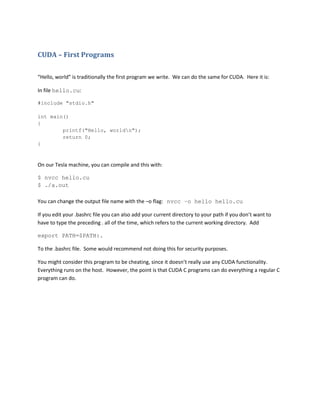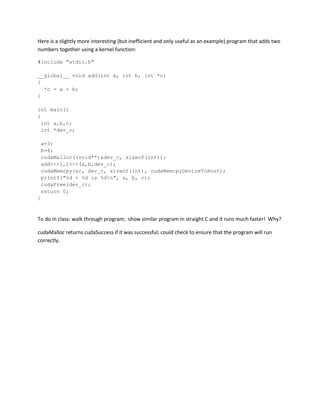The document provides examples of simple CUDA programs for adding vectors and 2D arrays using kernel functions. It begins with a "Hello World" CUDA program and explains how to compile and run it. It then shows a CUDA program that adds two numbers in a kernel function using thread indexing. Next, it presents a CUDA program for adding two vectors with one thread per element. Finally, it demonstrates how to map a 2D array to linear memory and write a kernel to add 2D arrays using block indexing.


![Example: Summing Vectors
This is a simple problem. Given two vectors (i.e. arrays), we would like to add them together in a third
array. For example:
A = {0, 2, 4, 6, 8}
B = {1, 1, 2, 2, 1}
Then A + B =
C = {1, 3, 6, 8, 9}
In this example the array is 5 elements long, so our approach will be to create 5 different threads. The
first thread is responsible for computing C[0] = A[0] + B[0]. The second thread is responsible for
computing C[1] = A[1] + B[1], and so forth.
Here is how we can do this with traditional C code:
#include "stdio.h"
#define N 10
void add(int *a, int *b, int *c)
{
int tID = 0;
while (tID < N)
{
c[tID] = a[tID] + b[tID];
tID += 1;
}
}
int main()
{
int a[N], b[N], c[N];
// Fill Arrays
for (int i = 0; i < N; i++)
{
a[i] = i,
b[i] = 1;
}
add (a, b, c);
for (int i = 0; i < N; i++)
{
printf("%d + %d = %dn", a[i], b[i], c[i]);
}
return 0;
}](https://image.slidesharecdn.com/cuda-firstprograms-200907042237/85/CUDA-First-Programs-Computer-Architecture-CSE448-UAA-Alaska-Notes-3-320.jpg)
![This is a rather roundabout way to add two arrays – our reason is because this will translate a little nicer
to the CUDA version. To compile and run it, we have to use g++ (since it uses some C++ style notations
that don’t work in C). Here is the CUDA version:
#include "stdio.h"
#define N 10
__global__ void add(int *a, int *b, int *c)
{
int tID = blockIdx.x;
if (tID < N)
{
c[tID] = a[tID] + b[tID];
}
}
int main()
{
int a[N], b[N], c[N];
int *dev_a, *dev_b, *dev_c;
cudaMalloc((void **) &dev_a, N*sizeof(int));
cudaMalloc((void **) &dev_b, N*sizeof(int));
cudaMalloc((void **) &dev_c, N*sizeof(int));
// Fill Arrays
for (int i = 0; i < N; i++)
{
a[i] = i,
b[i] = 1;
}
cudaMemcpy(dev_a, a, N*sizeof(int), cudaMemcpyHostToDevice);
cudaMemcpy(dev_b, b, N*sizeof(int), cudaMemcpyHostToDevice);
add<<<N,1>>>(dev_a, dev_b, dev_c);
cudaMemcpy(c, dev_c, N*sizeof(int), cudaMemcpyDeviceToHost);
for (int i = 0; i < N; i++)
{
printf("%d + %d = %dn", a[i], b[i], c[i]);
}
return 0;
}
blockIDx.x gives us the Block ID, which ranges from 0 to N-1. What if we used add<<<1,N>>>
instead? Then we can access by the ThreadID which is the variable threadIDx.x.](https://image.slidesharecdn.com/cuda-firstprograms-200907042237/85/CUDA-First-Programs-Computer-Architecture-CSE448-UAA-Alaska-Notes-4-320.jpg)
![As another example, let’s add two 2D arrays. We can define a 2D array of ints as follows:
int c[2][3];
The following code illustrates how the 2D array is laid out in memory:
for (int i=0; i < 2; i++)
for (int j=0; j< 3; j++)
printf("[%d][%d] at %ldn",i,j,&c[i][j]);
Output:
[0][0] at 140733933298160
[0][1] at 140733933298164
[0][2] at 140733933298168
[1][0] at 140733933298172
[1][1] at 140733933298176
[1][2] at 140733933298180
We can see that we have a layout where the next cell in the j dimension occupies the next sequential
integer in memory, where an int is 4 bytes:
c[0][0] at &c c[0][1] at &c + 4 c[0][2] at &c + 8
c[1][0] at &c + 12 c[1][1] at &c + 16 c[1][2] at &c + 20
In general, the address of a cell can be computed by:
&c + [(sizeof(int) * sizeof-j-dimension * i] + (sizeof(int)) * j
In our example the size of the j dimension is 3. For example, the cell at c[1][1] would be combined as
the base address + (4*3*1) + (4*1) = &c+16.
C will do the addressing for us if we use the array notation, so if INDEX=i*WIDTH + J
then we can access the element via: c[INDEX]
CUDA requires we allocate memory as a one-dimensional array, so we can use the mapping above to a
2D array.
To make the mapping a little easier in the kernel function we can declare the blocks to be in a grid that is
the same dimensions as the 2D array. This will create variables blockIdx.x and blockIdx.y that
correspond to the width and height of the array.](https://image.slidesharecdn.com/cuda-firstprograms-200907042237/85/CUDA-First-Programs-Computer-Architecture-CSE448-UAA-Alaska-Notes-5-320.jpg)
![#include "stdio.h"
#define COLUMNS 3
#define ROWS 2
__global__ void add(int *a, int *b, int *c)
{
int x = blockIdx.x;
int y = blockIdx.y;
int i = (COLUMNS*y) + x;
c[i] = a[i] + b[i];
}
int main()
{
int a[ROWS][COLUMNS], b[ROWS][COLUMNS], c[ROWS][COLUMNS];
int *dev_a, *dev_b, *dev_c;
cudaMalloc((void **) &dev_a, ROWS*COLUMNS*sizeof(int));
cudaMalloc((void **) &dev_b, ROWS*COLUMNS*sizeof(int));
cudaMalloc((void **) &dev_c, ROWS*COLUMNS*sizeof(int));
for (int y = 0; y < ROWS; y++) // Fill Arrays
for (int x = 0; x < COLUMNS; x++)
{
a[y][x] = x;
b[y][x] = y;
}
cudaMemcpy(dev_a, a, ROWS*COLUMNS*sizeof(int),
cudaMemcpyHostToDevice);
cudaMemcpy(dev_b, b, ROWS*COLUMNS*sizeof(int),
cudaMemcpyHostToDevice);
dim3 grid(COLUMNS,ROWS);
add<<<grid,1>>>(dev_a, dev_b, dev_c);
cudaMemcpy(c, dev_c, ROWS*COLUMNS*sizeof(int),
cudaMemcpyDeviceToHost);
for (int y = 0; y < ROWS; y++) // Output Arrays
{
for (int x = 0; x < COLUMNS; x++)
{
printf("[%d][%d]=%d ",y,x,c[y][x]);
}
printf("n");
}
return 0;
}](https://image.slidesharecdn.com/cuda-firstprograms-200907042237/85/CUDA-First-Programs-Computer-Architecture-CSE448-UAA-Alaska-Notes-6-320.jpg)